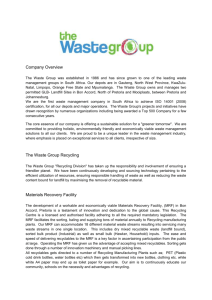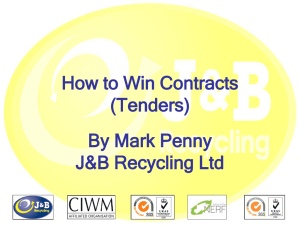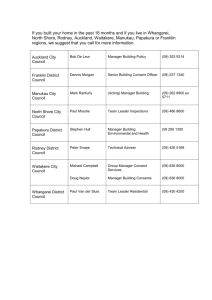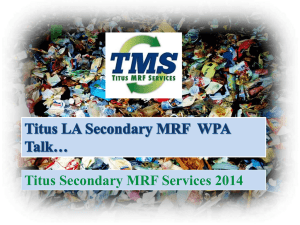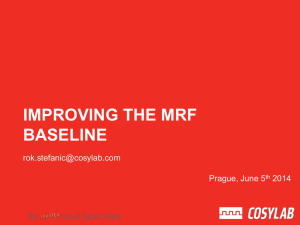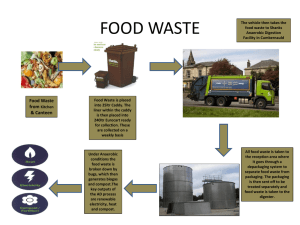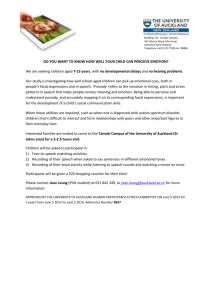Stuart Gane
advertisement
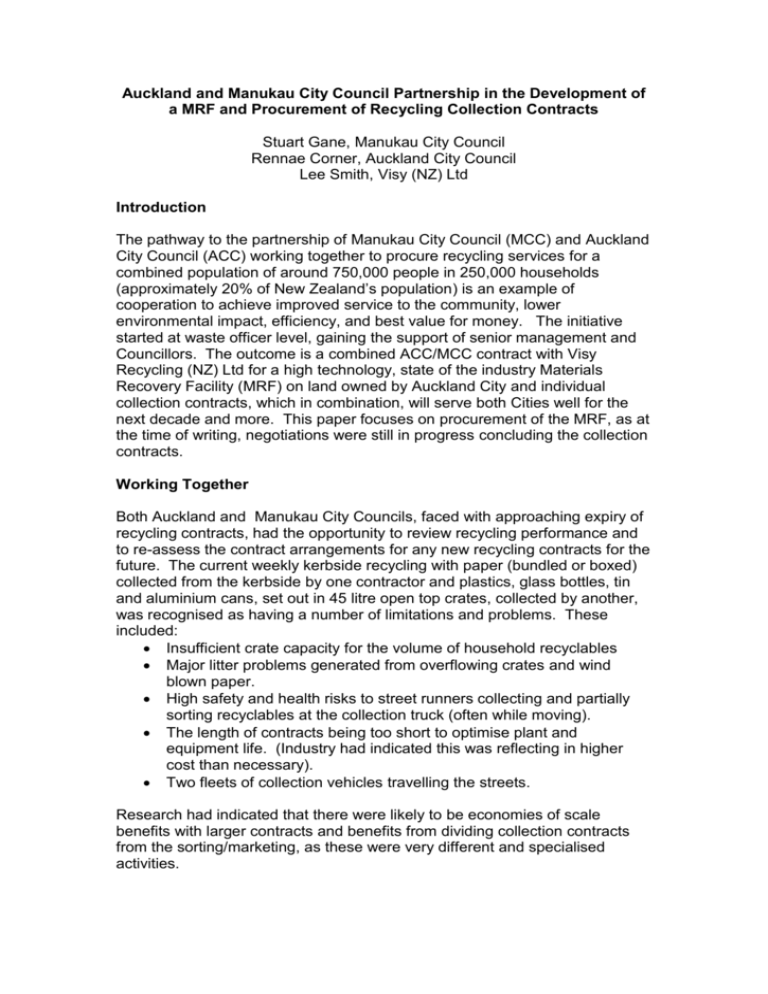
Auckland and Manukau City Council Partnership in the Development of a MRF and Procurement of Recycling Collection Contracts Stuart Gane, Manukau City Council Rennae Corner, Auckland City Council Lee Smith, Visy (NZ) Ltd Introduction The pathway to the partnership of Manukau City Council (MCC) and Auckland City Council (ACC) working together to procure recycling services for a combined population of around 750,000 people in 250,000 households (approximately 20% of New Zealand’s population) is an example of cooperation to achieve improved service to the community, lower environmental impact, efficiency, and best value for money. The initiative started at waste officer level, gaining the support of senior management and Councillors. The outcome is a combined ACC/MCC contract with Visy Recycling (NZ) Ltd for a high technology, state of the industry Materials Recovery Facility (MRF) on land owned by Auckland City and individual collection contracts, which in combination, will serve both Cities well for the next decade and more. This paper focuses on procurement of the MRF, as at the time of writing, negotiations were still in progress concluding the collection contracts. Working Together Both Auckland and Manukau City Councils, faced with approaching expiry of recycling contracts, had the opportunity to review recycling performance and to re-assess the contract arrangements for any new recycling contracts for the future. The current weekly kerbside recycling with paper (bundled or boxed) collected from the kerbside by one contractor and plastics, glass bottles, tin and aluminium cans, set out in 45 litre open top crates, collected by another, was recognised as having a number of limitations and problems. These included: Insufficient crate capacity for the volume of household recyclables Major litter problems generated from overflowing crates and wind blown paper. High safety and health risks to street runners collecting and partially sorting recyclables at the collection truck (often while moving). The length of contracts being too short to optimise plant and equipment life. (Industry had indicated this was reflecting in higher cost than necessary). Two fleets of collection vehicles travelling the streets. Research had indicated that there were likely to be economies of scale benefits with larger contracts and benefits from dividing collection contracts from the sorting/marketing, as these were very different and specialised activities. Early in the project both Councils, through their own research, identified that industry best practise for waste management, both in Australia and New Zealand, was focussing around a “three wheelie bin” system: all in recycling collected fortnightly (240 L Wheelie Bins) organic material collected fortnightly (240 L Wheelie Bins) residual refuse collected weekly or fortnightly (depending on whether putresibles wastes were included or not). 240 L wheelie bins collected fortnightly was agreed as the system to use. This system addressed the main concerns by increasing container capacity, minimising litter with lidded wheelie bins and paper contained, and high risks to street runners are virtually eliminated as operators carry out most collections using side arm lifters from within the safety of the truck cab. Inclusion of paper in the wheelie bin with the other recyclables also requires only one fleet of collection trucks. This system was compatible with having a separate contract for a MRF and collections, if separation of contracts did prove to be the best value. Discussions around co-operation within the region initially were held at Waste Officer level by Manukau City with Auckland, Papakura and Franklin Councils, as North Shore, Waitakere and Rodney had recently jointly tendered and established new waste contracts for the next 10 years. Following initial discussions Papakura and Franklin, while interested in the outcome and future potential opportunities, did not participate further in this process. Following further discussions between Auckland and Manukau, through to Chief Executive and Council levels, there was agreement to develop a Memorandum of Understanding (MOU) that formalised working together to procure recycling services. The MOU contained three principal objectives: to jointly evaluate the opportunity to acquire together or separately the Material Recovery Facility(s) (MRF), the operator of which will accept, sort and sell recyclables collected from the participant council areas; to jointly evaluate the opportunity to acquire together or separately the kerbside recyclables collection services for the participants; to obtain contractual arrangements covering the two services that enable each of the participants to achieve the most advantageous results, balancing costs and levels of service for the diversion of recyclables from land filling. A core working group, initially of four officers (two from each Council), later expanding to six, undertook the project. At an early stage the working group agreed that Auckland City Council would project lead the MRF procurement, as Auckland City had a potentially suitable site in Onehunga for a MRF, while Manukau City Council would project lead the collection procurement. This arrangement shared the workload and responsibilities between the Councils From the outset, the success of this project lay with the officers involved making it happen, as although respective Waste Management Plans include provision for working together with other Councils on waste minimisation, there were no high level Council or Regional policies mandating councils work together on waste minimisation. The Councils considered carefully different options for the procurement process including: Requests for expressions of interest Requests for information Requests for tenders. As both Councils had researched the options well, with investigative trips to Australia and extensive consultation with industry sectors, clear objectives had been developed. Consequently the decision was made to advertise request for tenders. Time was a constraint. In order for MCC to work with ACC, MCC had to extend its recycling contracts two years to coincide with the expiry of ACC’s contract, which ended on 30 June 2008. At least 10 – 12 months was required as a minimum for contractors to build a MRF and collection contractors to acquire new plant. The other procurement methods were considered to take longer to complete and were not expected to offer options that had not already been identified through the research already undertaken. The Tender Process One of the critical success factors which went into the development of the Request for tender (RFT) document, and the project as a whole is that both council’s ensured that the key objective of the project remained at the forefront at all times. This was: “To develop a facility which would recover, in a cost effective manner, as much recycling product as possible”. One of the first issues to address was whether or not the RFT process would be integrated i.e. MRF and collection tenders would be released together or whether a staged approach would be followed. The joint ACC and MCC team (the tender panel) employed the expertise of Consultancy firm, Impact Environmental to provide guidance and advice on how the tender should be structured. Based on the New South Wales model it was suggested that a MRF RFT should be released first. That way specifications, such as determining optimal compaction rates that would deliver the best recyclable product through the MRF, could be integrated into the development of the recycling collection RFT. Separate RFT’s for the MRF and collection contracts would also avoid a situation whereby a tenderer could leverage the profits of one activity to offset the costs of providing the other. Therefore a separate tender approach was seen as encouraging greater transparencies around the true costs of recycling components. A further issue to address was the degree to which councils wished to participate in the MRF operation. Options to consider were whether or not Auckland and Manukau wished to enter into a joint financial partnership with the MRF operators or whether they wished to maintain independence and limit risks. It was agreed that it was not the role, or the expertise of both Councils to process and market recycled material. The councils therefore decided to structure the RFT document and contract for a design, build, own, operate and transfer of a MRF back to council at the end of the contract. The RFT provided for the financing and operational accountability to be undertaken by the contractor. The basis of payment was set as a gate fee based on tonnage of received material. Whilst the aim of the RFT was not to have councils directly involved in the marketing of recycled product, both councils acknowledged that there were some benefits in sharing some of the market risks. This risk was based on a number of options ranging from full contractor risk to a shared risk approach. The RFT document outlined 10 key criteria. 1. The costs for building a MRF to process Auckland’s recyclables only 2. The costs for building a MRF to process Manukau’s recyclables only 3. The costs of building a MRF to process the combined recycling tonnages of both Manukau and Auckland Anecdotal evidence showed that it was far more cost effective for the two council to process their recyclables collectively, however this still had to be firmly established and presented to each council as part of the overall cost benefit analysis which formed part of the evaluation and selection process. 4. The costs per tonne based on a 14 year build own and operate transfer (BOOT) contract. The option was also provided for tenderers to nominate an alternative contract term. 5. The costs and logistics associated with building a MRF at an Auckland City owned site in Onehunga. (the Galway Street Landfill site) 6. The costs and logistics associated with building the MRF at an alternative site owned or leased by the tenderer. 7. The costs and logistics associated with building a MRF at both a council owned site and a privately owned site or any other combination tenderers may come up with. Auckland City owns a 3.6 ha site in the Industrial area of Onehunga. The site is roughly equal distance between Manukau and Auckland’s collection areas and is zoned to accept the heavy industrial activities classified within a MRF. However, both councils did not want to discount the possibility that other suitable, privately owned sites, may also prove to be a better, more cost effective, option and therefore did not want to lock tenderers into pricing for one site only. 8. The provisions of an education room and education programme over the life of the MRF. 9. The integration of green building principles into the overall design of the building where possible. The tender document also asked for pricing based on a shared and non shared risk profile. The Tender document was released on 19 November 2006 with a closing date of 6 March 2007. All tenderers were required to submit a conforming tender in order for the evaluation panel to score comparably between the various tender options. Non conforming tenders were welcome but not without a tenderer first submitting a conforming tender option. Seven tenders of were received from both New Zealand and Australian companies. A ‘one envelope’ system was agreed appropriate whereby price is considered up front with non price attributes. Preference for the one envelope system over the other common two envelope system was because there was significant complexity of options being canvassed in the RFT and consequent risks associated with errors or misinterpretations within the tenders occurring. The one envelope system removed some of this risk in the evaluation process. The evaluation process. An evaluation panel consisting of equal membership from both councils and an impartial Chair was established according to a pre-agreed Tender Assessment Plan. Where tenders were received for a MRF for one council only, each council had the option of using a local assessment panel to evaluate that particular portion of the tender. This option was not activated as it became clear that a regional MRF was the preferred option in terms of optimising processing costs and plant capabilities. A weighted attributes scoring system was used to evaluate the tenders. After evaluation the various criteria and ‘risk’ and ‘non risk’ sharing options the panel recommended that each council enter into an agreement with Visy Recycling (NZ) Ltd a new company established for the MRF but with parent company guarantee. Visy is one of the world’s largest privately owned paper recycling and packaging companies. Visy have over 20 years experience building and operating MRFs in Australia and around 10 years in the paperboard packaging market in New Zealand. Visy are also experienced in glass benefication. The tender offered by Visy was evaluated and scored highest of all the tenders. They had extensive experience with MRFs and demonstrated the ability to design and implement the latest technological plant capable of minimising the material lost in the sorting process. They also demonstrated a strong ability to meet market requirements for material, particularly with paper as they are manufacturers utilising paper as a raw material. Both Auckland and Manukau entered into separate, but mirror contracts, with Visy in May 2007. Visy was responsible for obtaining any necessary resource and building consents from both the local authority (Auckland City Council) and regional authority (Auckland Regional Council) The consents needed to begin construction work were granted in August 2007 and work is currently underway with a completion date of 30 June 2008. The councils have now turned their attention to procuring a recycling collection for each city based on a fortnightly 240 ltr wheelie bin system. MRF;s and what they do – including what is going to be special about the Auckland MRF. - VISY
